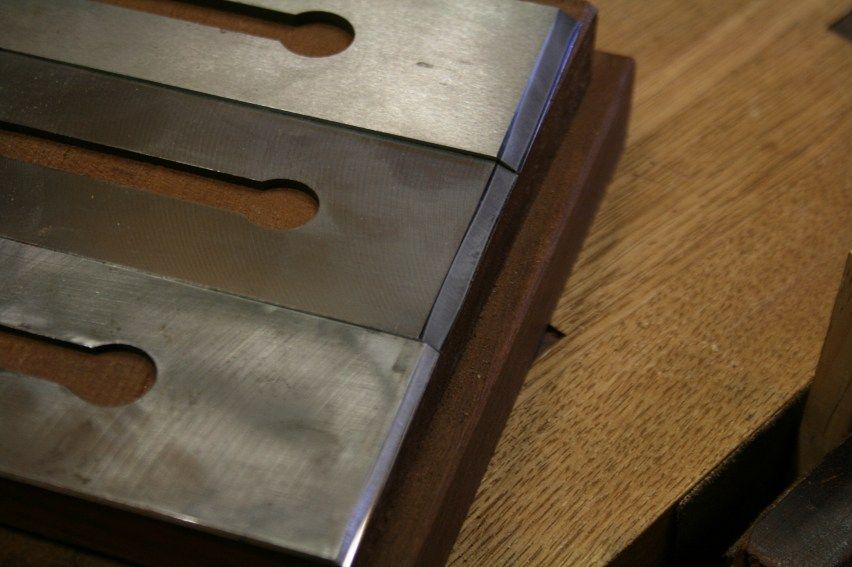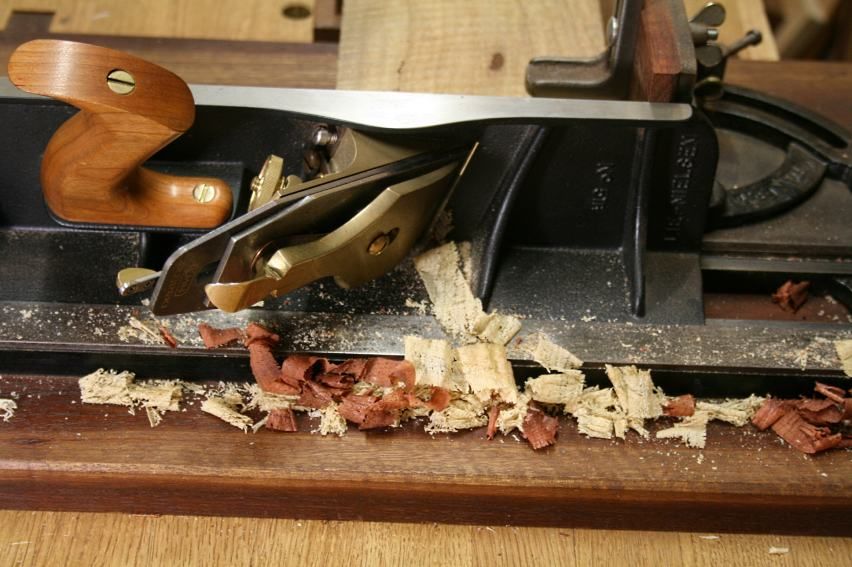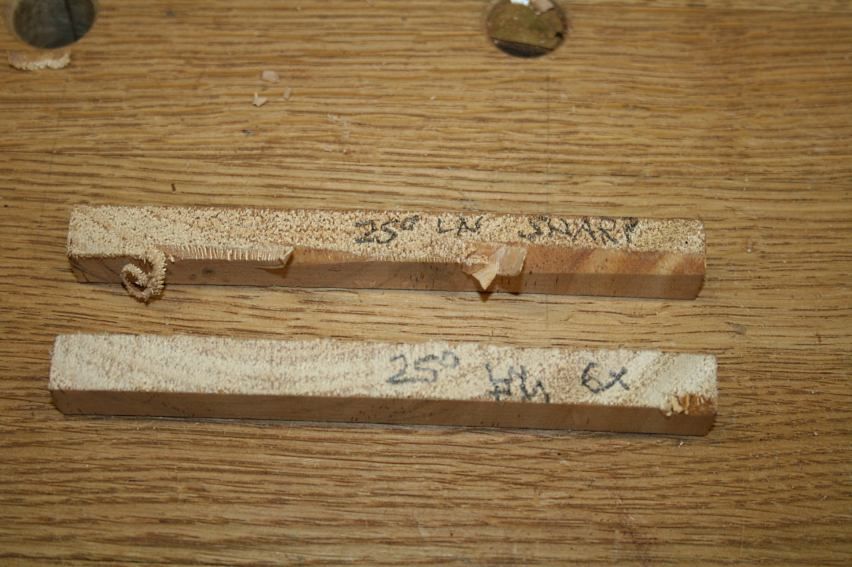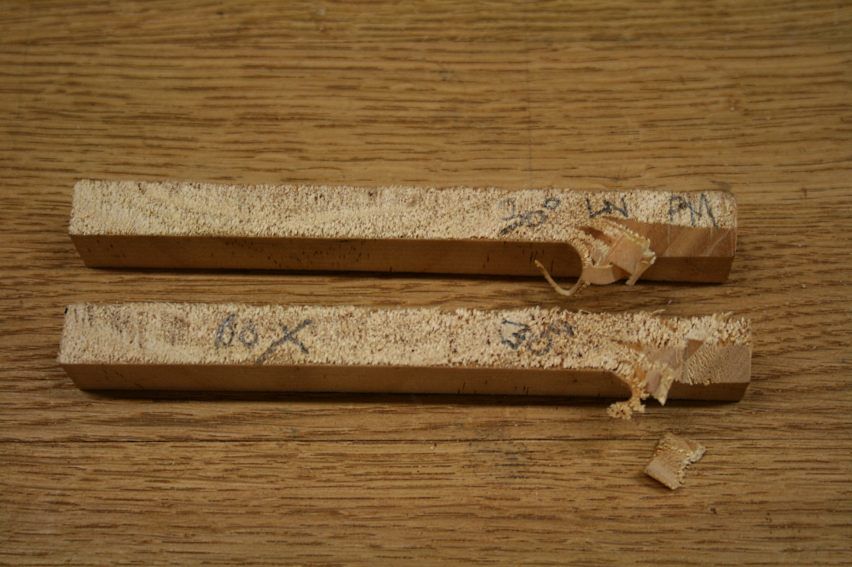 Thanks: 0
Thanks: 0
 Needs Pictures: 0
Needs Pictures: 0
 Picture(s) thanks: 0
Picture(s) thanks: 0
Results 1 to 6 of 6
-
1st October 2013, 02:18 AM #1
 About shooting planes and their blades
About shooting planes and their blades
I recently completed a little more blade testing, and I'd like to share my conclusions and the events that led up to them.
The recent comparison of the Veritas and Lie-Nielsen #51 shooting planes revealed poor performance of the O1 and A2 steels in the LN, and excellent performance of the A2 and PM-V11 steels in the Veritas. (For those that did not read the review, it is here: http://www.inthewoodshop.com/ToolRev...tingPlane.html).
One question remained unanswered in this review: "While these results were consistent, indicating that the LN A2 blades simply did not hold an edge as long as the Veritas blades, it did not inform whether the LNís bevel down orientation was responsible for increasing wear, or whether the quicker wearing blades were responsible for the increasing extra effort on pushing the LN #51 plane. What I really wanted at this point was a Lee Valley replacement blade for the LN plane, either A2 or PM-V11. I had neither".
Observations from an earlier review
Two years ago I made a comparison of the LN #51, LN #9 (both dedicated shooting planes), and the Veritas LA Jack (a general purpose plane) (Link below). These three planes are different in significant ways. The #51 has a cutting angle of 45 degrees but with a skew of 20 degrees. The #9 and the LAJ both have square blades, but the LAJ has a low angle bed of 12 degrees (for a cutting angle of 37 degrees) and the LN a bed of 20 degrees (for a cutting angle of 45 degrees).
What was interesting about the results was that, while the #51 came out top by a mile, the LA Jack proved to be capable of a better performance than the #9. In part this was believed to be due to the higher mass of the LA Jack, and in part to the lower cutting angle. I now believe that there is a third factor.
LN #51 plus PM-V11
It was Rob Lee that offered me a PM-V11 blade for the LN #51. Here it is below flanked by the Japanese Smoothcut on the left and the LN A2 on the right. The Veritas Stanley Replacement PM-V11 blade is roughly between the two in thickness.

I was warned that this blade does not fit a LN plane. On examination I discovered that this was due to the cut out on the LN chip breaker being set about 1/4" further back than on the Stanley and the Clifton chip breakers.

For the purpose of this experiment, I used the Clifton chip breaker, which was similar to the LN chip breaker in thickness. With this combination, and the frog moved forward, the LN #51 set up perfectly.


We returned to the same Curly Marri test board used in the Veritas Shooting Plane review, and the same procedure: sharpen blade and test the edge on end grain Radiata Pine. Aim for 60 completed shavings. Assess the performance subjectively. Photograph and test the edge on the Radiata Pine for objective evidence.
Results
As with the LN A2 blades, the PM-V11 was tested at both 25- and 30 degrees.
The results of planing with 25 degrees were very poor - I stopped planing after 6 shavings were barely completed. The plane was just not cutting, and the Radiata end grain test comfirmed this. After re-grinding and using the blade at 30 degrees, I tried again at 25 degrees. Results were the same. The PM-V11 simply failed at 25 degrees in the LN #51.
The results of the PM-V11 at 30 degrees were chalk-and-cheese. The #51 completed 60 shavings fairly well - not with the ease of the Veritas Shooting Plane plus PM-V11, but clearly so over the LN A2 blade. The LN A2 blade had been struggling from the halfway mark. The PM-V11 blade began to struggle about three quarters through the 60 shavings.
Photos of paring end grain Radiata Pine reveal the poor performance at 25 degrees ...

... and the decent performance at 30 degrees ...

Discussion
There are three conclusions that may be drawn from these results.
1. The first is that blade wear is correlated positively with bed angle. In short, the higher the bed angle, the greater the force imparted to the edge of the blade, and the faster the wear (by fracture). The lower bed of the bevel up Veritas creates a lower cutting angle (37 degrees), and this outlasts any blade in the common (45 degree) angled LN. This advantage remains even when the bevel in the LN is raised from 25 degrees (the only angle used in the Veritas) to 30 degrees.
A corollary is that the reason the LAJ was preferred to the #9 was primarily due to its lower cutting angle, and not simply its extra mass.
This is support for the belief that end grain is more easily planed with a low cutting angle, but the results also reveal that the blade life is longer with this configuration.
2. A second point is that any bevel down plane that is used for shooting will be expected to work significantly better with a 30 degree bevel over a 25 degree bevel. Interestingly, while LN do mention that blades may be honed at a higher angle, the LN #51 comes with a 25 degree bevel. I assume that this was because it uses a production blade common to the LN #4 1/2, #5 1/2 and #7 bench planes (my LN #4 1/2 arrived with a 25 degree blades as well).
A corollary here is that those that shoot with a BD bench plane, such as their trusty #7, risk rapidly wearing the blade. Get a BU plane for better shooting performance.
It must be emphasised that this assessment focussed on shooting planes and not bench planes. It is a situation analogous to a comparison of chopping versus paring dovetails. Shooting involves impact while planing is about abrasion. The results here are not to be interpreted that all BD planes will suffer with a 25 degree blade (although there is no advantage to using a blade at this angle on a BD plane).
3. The third conclusion is that the PM-V11 steel is more durable than A2 steel at 30 degrees when shooting. Its impact resistance at 25 degrees, as used here, on the other hand, was not as good as A2. In the testing of chisels (link below), all were used with 30 degree bevels as the test involved chopping end grain (dovetails). Here the PM-V11 was vastly more durable than A2. The simple recommendation is use 30 degrees on all chisels where impact is involved.
Regards from Perth
Derek
References:
http://www.inthewoodshop.com/Furnitu...sCompared.html
http://www.inthewoodshop.com/ToolRev...sCompared.htmlVisit www.inthewoodshop.com for tutorials on constructing handtools, handtool reviews, and my trials and tribulations with furniture builds.
-
1st October 2013 02:18 AM # ADSGoogle Adsense Advertisement
- Join Date
- Always
- Location
- Advertising world
- Posts
- Many
-
2nd October 2013, 03:21 AM #2

Got me thinkin' what the bed angle and steel in my Rogers mitre plane are. I'll check the bed angle tomorrow if I can. Be interested in seeing it compared to some of the new guns on the block.
Have you used a rogers Derek?
Cheers
OG.Some give pleasure where ever they go, others whenever they go!
-
2nd October 2013, 03:29 AM #3

oops, Anarak Bob gave the answer - 15 degrees 30 minutes.
Some give pleasure where ever they go, others whenever they go!
-
2nd October 2013, 08:25 AM #4

Interesting comparisons.
Higher angle and more resistance and the resulting wear has always annoyed me.
Have you had the chance to compare Hock blades in shooting planes ? .... I'm having a lot of success with those. I don't use planes so much anymore, but with spokeshaves I've found Hock to work best; long time between sharpening despite the heat from my grind/buff. And one of them I use flipped with a high angle and still holds up very well.
-
2nd October 2013, 05:10 PM #5

Hi Jake
The information about angles and steel choice for blades on shooting planes does not apply to spokeshaves and bench planes. One involves impact, which leads to blade wear due to chipping. The other involves abrasion, which leads to wear due to erosion.
I hear good things generally about Hock blades. I have a few and have been happy with them. As far as I am aware, only Hock and Lee Valley make replacement blades for Stanley spokeshaves. I've not used either.
While I have your attention, I'd be interested in any strategy ideas you may have about the following chair I am about to build. It is a design that has only been made with a CNC machine, but I plan on doing this with hand tools. Here is a link: https://www.woodworkforums.com/f187/a...-chair-177279/
Regards from Perth
DerekVisit www.inthewoodshop.com for tutorials on constructing handtools, handtool reviews, and my trials and tribulations with furniture builds.
-
2nd October 2013, 06:52 PM #6
Similar Threads
-
Mitre vs Shooting Planes - which one and why?
By Tools4Me in forum WOODWORK - GENERALReplies: 10Last Post: 24th October 2011, 08:20 PM -
Shooting planes compared
By derekcohen in forum HAND TOOLS - UNPOWEREDReplies: 8Last Post: 17th March 2011, 01:44 PM -
so i got some plane blades but need planes to put them in
By weisyboy in forum HAND TOOLS - UNPOWEREDReplies: 2Last Post: 14th February 2009, 12:10 PM -
removing stuck blades from old planes
By bannock in forum JAPANESE HAND TOOLSReplies: 13Last Post: 31st January 2008, 04:29 PM -
Shooting board planes
By Arron in forum HAND TOOLS - UNPOWEREDReplies: 11Last Post: 19th September 2005, 02:30 PM



 Likes:
Likes: 


 Reply With Quote
Reply With Quote

